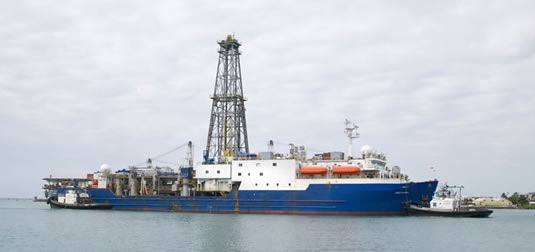IODP Expedition 320
Pacific Equatorial Age Transect 1
Daily Science Report for 31 March 2009
LOCATION: Hole U1333A (PEAT-3C),10°30.997'N, 138°25.175'W (4854 mbsl)
SCIENCE UPDATE: Cores U1333A-1H to 10H cored to 95.0 m CSF-A, recovered 98.85 m (104%) and Cores 11X to 17X cored from 95.0 to 158.4 m CSF-A, recovered 62.5 m (99%). These extend from early Miocene to middle Eocene. Cores 1H-13X have been split and are dominantly nannofossil ooze with E/O boundary in Core 13X.
Daily Science Report for 30 March 2009
LOCATION: Hole U1333A (PEAT-3C),10°30.997'N, 138°25.175'W (4854 mbsl)
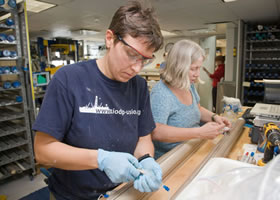 SCIENCE UPDATE: Arrived at Site U1333 (PEAT-3C) at 1400 hr, prepare drill string for coring at Hole U1333A. Completed processing cores from Hole U1332C. Held science meeting to review Site U1332 results and discuss Site U1333 science and operations plan. Plan is for three holes to basement (~175 m) to obtain complete section.
SCIENCE UPDATE: Arrived at Site U1333 (PEAT-3C) at 1400 hr, prepare drill string for coring at Hole U1333A. Completed processing cores from Hole U1332C. Held science meeting to review Site U1332 results and discuss Site U1333 science and operations plan. Plan is for three holes to basement (~175 m) to obtain complete section.
Daily Science Report for 29 March 2009
LOCATION: Hole U1332C (PEAT-2C). 11°54.74'N, 141°2.74'W (4926 mbsl)
SCIENCE UPDATE: Cores U1332-15X to 18X penetrated from 118.0 to 155.5 m DSF; recovered 19.6 (52%). Coring finished at Hole U1332C; start transit to Site U1333 (PEAT-3C).
Daily Science Report for 28 March 2009
LOCATION: Hole U1332C (PEAT-2C). 11°54.74'N, 141°2.74'W (4926 mbsl)
SCIENCE UPDATE: Offset 30 m to north and prepare to spud Hole U1332C to cover gaps in first two holes. Cores U1332C-1H to 13H and 14X taken from 0 to 118 m DSF; recovered 128.4 m (109%).
Daily Science Report for 27 March 2009
LOCATION: Hole U1332B (PEAT-2C). 11°54.72'N, 141°2.74'W (4926 mbsl)
SCIENCE UPDATE: Cores U1332B-10H to 13H penetrated from 76.5 to 110.1 m DSF; recovered 38.0 m (114%). Cores 14X to 18X penetrated from 110.1 to 148.6 m DSF; recovered 23.4 m (61%). Lithology/ages are same as in Hole U1332A. Overlapping core coverage between holes continues to be impacted by ship heave. Finished coring Hole U1332B, offset 30 m to north and prepare to spud Hole U1332C to cover gaps in first two holes.
Daily Science Report for 26 March 2009
LOCATION: Hole U1332B (PEAT-2C). 11°54.72'N, 141°2.74'W (4926 mbsl)
SCIENCE UPDATE: Cores U1332B-1H to 9H penetrated from 0 to 76.5 m DSF; recovered 80.4 m (105%). Lithology/ages are same as in Hole U1332A. Overlapping core coverage between holes complicated by ship heave (~3 m); third hole will fill gaps. Heave negatively impacted formation temperature measurements.
Daily Science Report for 25 March 2009
LOCATION: Hole U1332A (PEAT-2C). 11°54.71'N, 141°2.74'W
SCIENCE UPDATE: Cores U1332A-15X to 18H penetrated from 125.9 to 152.4 m DSF; recovered 26.5 m (52%). Radiolarian ooze with clay and radiolarian nannofossil ooze grading downward to porcellanite and radiolarian ooze. Cores 17X and 18X comprise chert, clay, and basalt; the base of 18X recovered a very nice piece of basalt about 10 cm long with a vein filled fracture along nearly its entire length. Core 15X is middle Eocene, but ages below are elusive at this time.
One logging run with the natural gamma, density, and magnetic susceptibility tools successfully obtained data from the base of the hole to ~90 m WSF. The log data help define the high-priority section in the lower part of the hole that was only poorly recovered in the Hole U1332A cores so they can be better targeted in the second hole. The basal section above basalt is characterized by an interval of higher density and lower magnetic susceptibility. When retrieving the logging tool string, the tool parted from the logging wireline. Efforts to retrieve the tool were not successful so the hole will be sealed with cement. We will then offset 20 m to the west and start Hole U1332B about 5 m deeper than the first hole.
Daily Science Report for 24 March 2009
LOCATION: Hole U1332A (PEAT-2C). 11°54.71'N, 141°2.74'W
SCIENCE UPDATE: Cores U1332A-11H to 14H penetrated from 89.4 to 125.9 m DSF; recovered 37.2 m (102%). Cores 15X to 18X penetrated from 125.9 to 152.4 m; recovered 13.8 m (52%). Cores 5H to 12H comprise nannofossil and radiolarian oozes with varying amounts of clay and diatoms (late Eocene to early Oligocene). Prepared hole for downhole logging and lowered first string (natural gamma, density, and magnetic susceptibility tools) into the hole.
Daily Science Report for 23 March 2009
LOCATION: Site U1332 (PEAT-2C). 11°54.70'N, 141°2.74'W
SCIENCE UPDATE: Cores U1332A-1H to 10H penetrated from 0 to 89.5 m DSF; recovered 94.6 m (106%). Cores 1H to 4H comprise surficial clay (Quaternary) and then alternating radiolarian and nannofossil ooze with increasing amounts of nannofossil ooze downcore (Miocene to Oligocene). After coring to basement (~162 m DSF), we will log Hole U1331A with the "paleo"-Combo and FMS-Sonic tool strings.
Daily Science Report for 22 March 2009
LOCATION:
0500: End Hole U1331C and start transit to PEAT-2C.
1445: Arrive Site U1332 (PEAT-2C). 11°54.7'N, 141°02.7'W
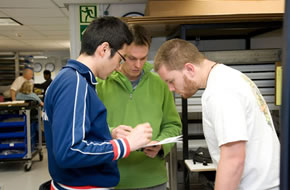 SCIENCE UPDATE:
SCIENCE UPDATE:
HOLE U1331C: Successfully cored the early Eocene section below the chert and above basement that was one of the highest priority sections at this site and was poorly recovered in the previous two holes. This time the drillers successfully obtained APC Cores U1331C-17H and 18H (177.0 to 189.0 DSF m) coring 12.0 m and recovering 14.0 m (117%). Judging by the deformation of the cutting shoe and a bent 15-foot section of core barrel, it was surmised that Core 18H had more than vigorously encountered basaltic basement. Sediment recovered is early Eocene (~51-53 Ma) radiolarian ooze and nannofossil ooze with hydrothermal red staining. End of Site U1331 (PEAT-1C).
SITE U1332 (PEAT-2C): Arrived at Site U1332 and began preparations for coring.
Daily Science Report for 21 March 2009
LOCATION: Hole U1331C (PEAT-1C): 12°4.09'N, 142°9.72'W
SCIENCE UPDATE:
HOLE U1331C: After drilling through the chert interval without coring (157.5 to 177.0 m), we made the third attempt to core the short interval below the chert and above the top of basaltic oceanic crust. This early Eocene section was one of the highest priority sections at this site and only very poorly recovered in Hole U1331A. The drillers successfully obtained APC Cores U1331C-17H and 18H (177.0 to 189.0 m) coring 12.0 m and recovering 14.0 m (117%). End of Core 18H appears to have encountered basement. Cores not yet split, but basal carbonate section may be very thin. Coring at Site U1331 was completed. Next site will be Site PEAT-2C (Site U1332).
SITE U1331 REPORTS: Held Site U1331 science meeting; scientists working on site reports.
Daily Science Report for 20 March 2009
LOCATION: Hole U1331C (PEAT-1C): 12°4.09'N, 142°9.72'W
SCIENCE UPDATE:
HOLE U1331C: Offset 20 m west of Hole U1331B. APC coring in this hole is focused on recovering intervals spanning the few core gaps that the first two holes do not cover. APC Cores U1331C-1H to 4H (0.0 to 38 m), 6H (59.0 to 68.5 m), 8H (92.5-102.0 m), 10H (102.5 to 112.0 m), and 12H to 14H (129.0 to 157.5 m), cored 95.0 m, recovered 94.27 m (99%).
SITE U1331 REPORTS: Assembling and integrating data sets from first two holes in preparation for first science meeting (Saturday) and producing site reports.
Daily Science Report for 19 March 2009
LOCATION: Hole U1331B (PEAT-1C): 12°4.10'N, 142°9.71'W
SCIENCE UPDATE:
HOLE U1331B: XCB Cores U1331C-16X, 17H, and 18X cut from 143.1 to 166.3 m, recovered 13.7 m (59%). Drilled without coring through chert from 166.3 to 177.0 m. Attempted APC Core 20H below chert in early Eocene basal carbonate section but did not penetrate formation. Attempted to XCB remaining basal carbonate section (22X) from 179.0 to 188.5 m, but no recovery. Next hole will make another attempt to recover this interval.
HOLE U1331C: Offset 20 m west of Hole U1331B and started APC coring. Our plan is to recover ~12 cores spanning the few core gaps that the first two holes do not cover and to provide additional sediment for the full range of postcruise research.
SITE U1331 REPORTS: Assembling and integrating data sets from first two holes in preparation for first science meeting (Saturday) and producing site reports.
Daily Science Report for 18 March 2009
LOCATION: Hole U1331B (PEAT-1C): 12°4.10'N, 142°9.71'W
SCIENCE UPDATE:
HOLE U1331A: Cores U1331A-11H to 22X are radiolarian nannofossil oozes grading downward to radiolarian ooze and then chert; chert section is poorly recovered; carbonate ooze recovered immediately above basaltic basement. Downhole logging completed one run to total depth of the borehole with the "paleo"-combo tool string (natural gamma, density, and magnetic susceptibility). Data provided important information on high-priority lowermost sediment section that we will attempt to APC core in Hole U1331B (below chert and above basaltic basement).
HOLE U1331B: Offset 20 m west of Hole U1331A and started coring Hole U1331B five meters deeper to cover gaps between cores in the first hole. APC Cores U1331B-1H through 15H recovered from 0 to 134.2 m, 139.4 m recovered (104%). Whole-round susceptibility and density data indicate 5 m offset is working well to obtain a nearly complete section for cores recovered to ~139 m. All cores finished with whole round fast-track data collection and data loaded for stratigraphic correlation. Expect to start splitting cores shortly. Five formation temperature measurements made at 20, 30, 48, 67, and 96 m; four good results (one moved during measurement). Plan is to APC core until the cherts, drill without coring through the cherts, and then APC the sediment section below chert and above basement.
Daily Science Report for 17 March 2009
LOCATION: Hole U1331A (PEAT-1C): 12°4.08'N, 142°9.70'W
SCIENCE UPDATE: XCB Cores U1331A-16X through 22X recovered from 138.2 to 190.6 m (dsf), 13.6 m recovered (26%). All cores finished with whole round fast-track and multisensor track data collection data loaded for stratigraphic correlation. Cores through 13H have finished with natural gamma measurements on whole rounds. Cores 5H-10H have been split, described, and subjected to initial discrete physical properties and paleomagnetic measurements. Cores 5H-10H are alternating lithologies of nannofossil ooze and radiolarian ooze (the latter looking like chocolate mousse). Hole being prepared for downhole logging. After logging we will start coring on Hole U1331B which will be offset 20 m west and 5 m deeper.
Daily Science Report for 16 March 2009
LOCATION: Hole U1331A (PEAT-1C): 12°4.08'N, 142°9.70'W
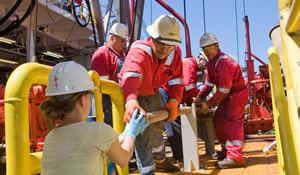 SCIENCE UPDATE: APC Cores U1331A-1H through 15H recovered from 0 to 138.2 m, 141.3 m recovered (102%). Paleontology on all core catchers - Quaternary to middle Eocene. Interstitial water samples have been collected and are being processed. Cores 1H-6H finished with whole-round track data collection - data loaded into stratigraphic correlation software. Cores 1H-4H have been split, described, and subjected to initial discrete physical properties and paleomagnetic measurements. Cores 1H to 4H are red clay passing downward to nannofossil ooze with varying amounts of radiolaria and few diatoms. Paleomagnetic data and orientation appears to be of excellent quality. Labs and core flow coming up to speed.
SCIENCE UPDATE: APC Cores U1331A-1H through 15H recovered from 0 to 138.2 m, 141.3 m recovered (102%). Paleontology on all core catchers - Quaternary to middle Eocene. Interstitial water samples have been collected and are being processed. Cores 1H-6H finished with whole-round track data collection - data loaded into stratigraphic correlation software. Cores 1H-4H have been split, described, and subjected to initial discrete physical properties and paleomagnetic measurements. Cores 1H to 4H are red clay passing downward to nannofossil ooze with varying amounts of radiolaria and few diatoms. Paleomagnetic data and orientation appears to be of excellent quality. Labs and core flow coming up to speed.
Daily Science Report for 15 March 2009
LOCATION: At Site PEAT-1C (Site U1331).
SCIENCE UPDATE: Arrived on site, began dynamic positioning over location of Site PEAT-1C, and started assembling and lowering drill string to seafloor. Scientists and technical staff continue to prepare for coring, logging, and lab operations in anticipation of first core on deck.
Daily Science Report for 14 March 2009
LOCATION: En route to Site PEAT-1C; Arrived vicinity of PEAT-1C (Site U1331) just before midnight.
SCIENCE UPDATE: Chief scientist gave presentation on PEAT-1C science objectives and operations to science party. Pre-site operations meeting with drill crew. Conducted first practice of complete core flow, sampling, and data acquisition for midnight to noon shift. Chief scientists review lab team methods. Ships crew, scientists and technical staff continue to prepare for coring, logging, and lab operations. Anticipate first core recovery late 15 March.
Daily Science Report for 13 March 2009
LOCATION: En route to Site PEAT-1C.
SCIENCE UPDATE: Ships crew, scientists and technical staff continue to prepare for coring, logging, and lab operations. Orientation to downhole logging tools given to scientists. Noon to midnight shift conducted first practice of complete core flow, sampling, and data acquisition. First drafts of lab team methods submitted for chief scientist review. APC/XCB core barrels removed from their quivers in preparation for coring. Estimated time of arrival (ETA) at PEAT-1C is late 14 March.
Daily Science Report for 12 March 2009
LOCATION: En route to Site PEAT-1C.
SCIENCE UPDATE: Ships crew, scientists and technical staff continue to prepare for coring, logging, and lab operations. Reviewed planned logging operations at first site with chief scientists. Estimated time of arrival (ETA) at PEAT-1C is late 14 March.
Daily Science Report for 11 March 2009
LOCATION: En route to Site PEAT-1C.
SCIENCE UPDATE: Ships crew, scientists and technical staff continue to prepare for coring, logging, and lab operations. Conducted pre-site operations planning meetings. Estimated time of arrival (ETA) at PEAT-1C is late 14 March.
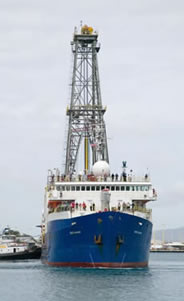 Daily Science Report for 10 March 2009
Daily Science Report for 10 March 2009
LOCATION: En route to Site PEAT-1C.
SCIENCE UPDATE: 1500, 10 March - With great reverence and gratitude for all those who made it possible, the participants of IODP PEAT I Expedition 320 departed Honolulu, Hawaii (USA) on the JOIDES Resolution.
Following an ~4 day transit, we will begin scientific coring and logging operations at PEAT-1C in the central Pacific Ocean. Today's activities included an orientation to PEAT program core sampling, lab team preparations, and fully enjoying the departure from Honolulu and the JOIDES Resolution's return to scientific ocean drilling.
Daily Science Report for 9 March 2009
LOCATION: Pier 29, Honolulu Harbor, Honolulu, Hawaii (USA).
SCIENCE UPDATE: Lab teams composed of scientists and technical staff continue learning labs, instruments, and methods. Lab groups start developing sampling requirements for shipboard analyses. Chief scientists, curator, and staff scientists meet to prepare for sampling meeting with scientists. Start developing draft table of contents for the expedition reports. Free afternoon for scientists as it is their last day on land until 5 May. Departure for our first site, PEAT-1C, is scheduled for 1500, 10 March.
Daily Science Report for 8 March 2009
LOCATION: Pier 29, Honolulu Harbor, Honolulu, Hawaii (USA)
SCIENCE UPDATE: Scientists continue orientation with introduction to labs, shipboard responsibilities and obligations, overall expedition reports and publications, work flow and shifts, as well as postcruise meetings and obligations. Chief scientists gave presentation on core depths, stratigraphic correlation, and composite sections. All scientists and USIO staff attend Captain's introduction and initial safety orientation including lifeboat tour. Lab teams continue to learn instruments and methods.
Daily Science Report for 7 March 2009
LOCATION: Pier 29, Honolulu Harbor, Honolulu, Hawaii (USA)
SCIENCE UPDATE: Scientists and technical staff began shipboard orientation and planning for PEAT I. Activities included personnel introductions, review of PEAT I expedition science objectives by chief scientists, introduction to new sample and database conceptual framework as well as to the information technology services (computers, servers, network, email, etc). Sedimentologists and paleontologists started learning the new descriptive information applications. Lab groups started orientation for lab instrumentation, methods, and safety. Lab tours conducted for entire science party. Tours conducted of ship for entire IODP Science and Technology Panel, University of Hawaii geology class, NSF visitors, and others.
Daily Science Report for 6 March 2009
LOCATION: Pier 29, Honolulu Harbor, Honolulu, Hawaii (USA)
SCIENCE UPDATE: PEAT I Expedition (320) Chief Scientists and USIO staff continue extensive crossover with off-going staff and start preparing orientation activities for oncoming scientists. PEAT I scientists moved onto the ship and started to explore the new labs and ship. Conducted tours of the laboratories for University of Hawaii, UNESCO/NOAA, and other visitors. Texas A&M Health, Safety, and Environment continued audit of new laboratories. Started loading of drilling mud and some air freight.
Daily Science Report for 5 March 2009
LOCATION: Arrive Pier 29, Honolulu Harbor, Honolulu, Hawaii (USA)
SCIENCE UPDATE: PEAT I Expedition (320) Chief Scientists and USIO staff met the ship upon arrival. Started work with departing scientists and staff to learn new labs, instruments, software, systems, and procedures. Debriefing of Readiness Assessment Team scientists and reports. Texas A&M Health, Safety, and Environment initiated audit of new laboratories.
